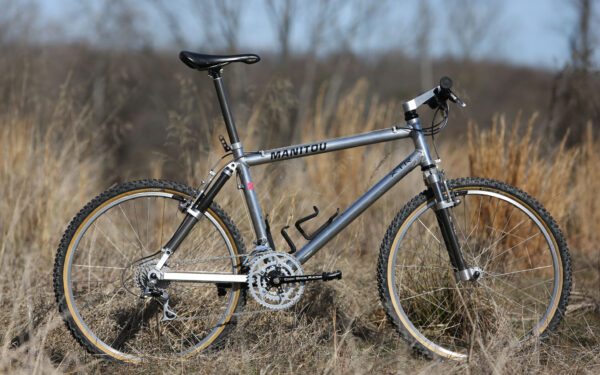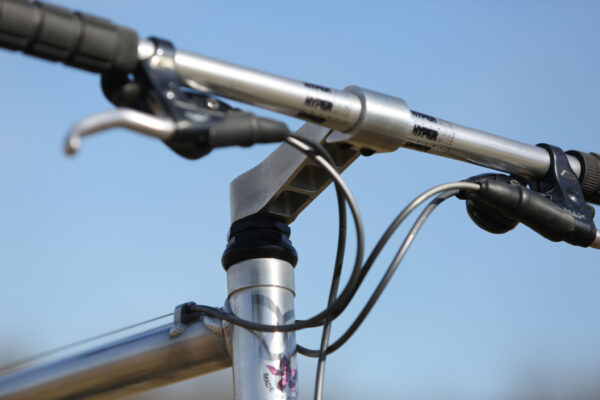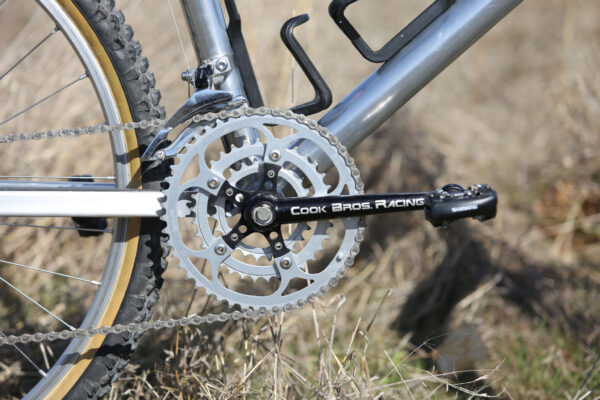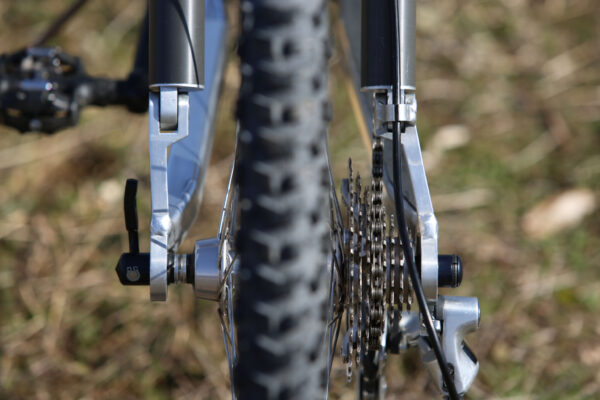The mac daddy of FS bikes of the 90s
The late 80s and early 90s were an amazing time for mountain biking, especially for the rapidly growing component cottage industry in the US. Aluminum was king and any design seemed possible, thanks to application of CNC machining to component manufacturing.
Starting lines at major NORBA or Grundig World Cup races featured bikes adorned with components with wild anodized finishes that would make anything from the I9 catalog look bland by comparison. Frame design, however, was still fairly traditional and the concept of a functioning full suspension design still seemed beyond the horizon.

The Invention That Changed Everything
Doug Bradbury had been on the scene for over half a decade quietly making some of the coolest aluminum bikes out of his garage in Colorado Springs. By 1990, along with Paul Turner, Bradbury was largely credited with bringing suspension to the world of mountain biking, Paul with the RockShox RS-1 and Doug with his elastomer sprung Manitou fork.
That year Juli Furtado won the inaugural World Championships, while John Tomac famously raced to a 7th in XC and 4th in DH with drop bars, each riding one of Doug’s prototype Manitou forks. In 1991, with another year of development under his belt and a new collaboration with Easton, Doug turned his attention to developing a full suspension frame.

 In order to achieve the 145mm rear spacing Doug cut a normal Shimano XTR hub in half and installed a widening spacer between the two halves
In order to achieve the 145mm rear spacing Doug cut a normal Shimano XTR hub in half and installed a widening spacer between the two halves

Manitou FS Prototype
Rather than look outside for a functional shock, Doug opted for a known design – that of his suspension fork – and put it in place of the seat stays. His forks offered a modest 1.5” to 2” of travel under the best of circumstances and those figures remained intact when applied to the rear end of the bike.
Combined with a low pivot directly behind the bottom bracket, 70.5/73 degree HT/ST combo, short 16.375” stays, and a tight 42.75” wheelbase the Manitou FS was a killer XC design that pedaled well uphill and was responsive and agile when pointed the opposite direction, with the suspension doing far more than smoothing out mere washboards.
As if the geometry wasn’t forward thinking enough, the 24” top tube, coupled with what was at the time considered a short 120mm stem and 115/145mm spacing on the wheels, all with a hardtail comparable weight of 24.5lbs made for a remarkably advanced bike.
The frame was built out of Easton’s then-new Varilite 7005 series aluminum tubing and featured extensive use of CNC machining to fabricate the swingarm. Though not as sophisticated as the later Answer versions of the bike, the unorthodox shock, raw aluminum look and the aerospace grade machined sections made the Manitou FS prototype a sensation when it was first shown at Interbike.




Ahead of the Curve
Today, virtually every manufacturer has multiple full suspension bikes in their lineup. In the early 90s, however, major companies like Trek, Cannondale and Specialized were just putting forth their first attempts at rear-sprung rigs. Most of those early designs just plainly didn’t work, with some being utterly laughable.
That’s why this bike, built by a guy in his garage is simply amazing. Not only was it striking to behold, but it actually worked well on the trail. I’ve ridden the FS a fair amount both out west and more recently on the east coast and the bike always puts a smile on my face. I think riders used to modern bikes would quickly find the limits of the Manitou, but for those who can keep it in perspective of its time would likely see it for the impressive piece of kit it was, and is.
 Shimano’s M900 XTR group wasn’t released to the public until 1992, however Doug and a few other builders received prototype parts in 1991
Shimano’s M900 XTR group wasn’t released to the public until 1992, however Doug and a few other builders received prototype parts in 1991
 The Cook Bros Dogbone… one of the coolest crank designs ever made.
The Cook Bros Dogbone… one of the coolest crank designs ever made.


 Doug designed and built not only his frames, forks and stem, but also these custom wide hubs. This 115mm front hub features an early Paul component skewer custom made for the wide hubs
Doug designed and built not only his frames, forks and stem, but also these custom wide hubs. This 115mm front hub features an early Paul component skewer custom made for the wide hubs
 Doug’s contribution to mountain biking can’t be overstated. Not only did he launch one of the larger fork brands, after selling his design and intellectual rights to Answer, but this frame design would also see mass production under the Answer brand. Under the skilled pilotage of Jurgen Beneke, Bradbury’s dual suspension design won the 1993 UCI DH World Cup, as well as the 1994 Mammoth Kamikaze and Rebook Eliminator.
Doug’s contribution to mountain biking can’t be overstated. Not only did he launch one of the larger fork brands, after selling his design and intellectual rights to Answer, but this frame design would also see mass production under the Answer brand. Under the skilled pilotage of Jurgen Beneke, Bradbury’s dual suspension design won the 1993 UCI DH World Cup, as well as the 1994 Mammoth Kamikaze and Rebook Eliminator.
My only complaint about it is a bit of play and lateral flex in the rear end, which at times make it feel like the bike wanders a bit when pushed hard. On paper it’s very similar to many modern FS bikes, with head tube / seat tube angles and reach in striking distance of common FS bikes. The biggest difference is the seat to bar drop which results in a bit more of a stretched out position over modern bikes. Compared to a modern 29er The Manitou’s wheelbase is a full two inches shorter, which makes it a bit easier to handle in tight technical sections – up to a point.

The Manitou’s design was extremely forward thinking for the time and much more than a glimpse of what was to come.
Later, Bradbury’s design was licensed to Marin (among others) where Jurgen took the bike to a 2nd at the UCI DH WC. Bradbury’s forward-thinking prototype suspension bike remained in production until 1996, after which, a new design was released with a more conventional linkage-driven single shock, mounted under the top tube.
Doug stayed in the industry supporting Answer in their product development team through the mid 1990s and later joined forces with John Tomac to start the Tomac bicycles brand. Though the Tomac brand was relatively short lived, the Manitou brand, Doug’s original creation, is still alive and well. In fact their newest lineup of forks has returned to the classic livery found on his first bikes, a testament to the lasting impact he made on the sport of mountain biking
BRANDS
Completed Projects:
Current Projects:
Newsletter sign up:
Subscribe to our newsletter to receive info on our latest projects and new podcast releases



